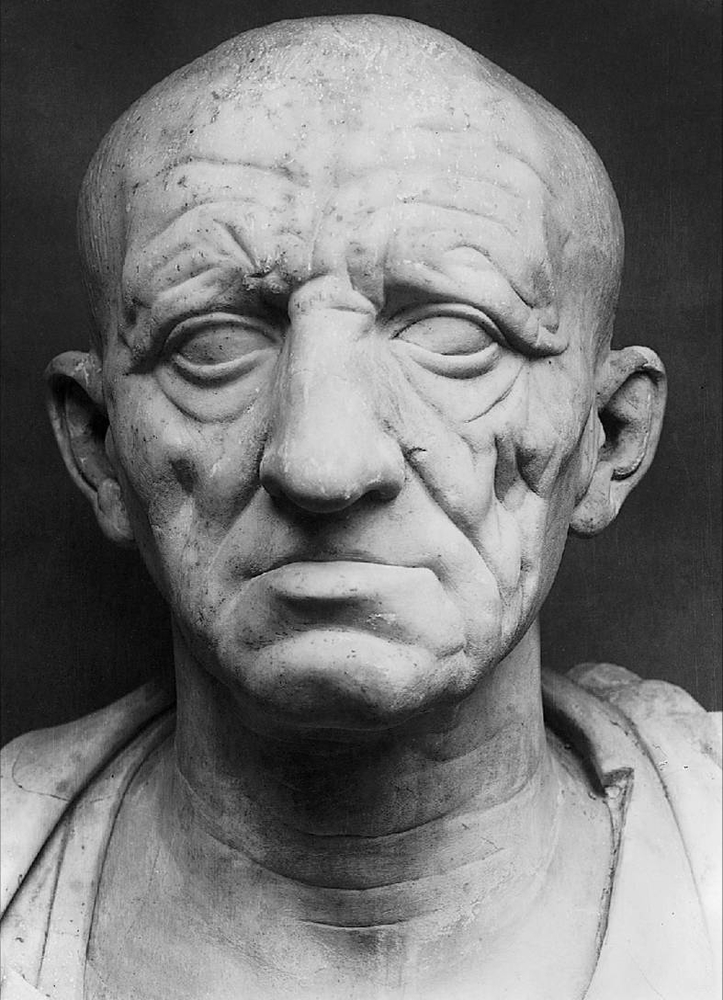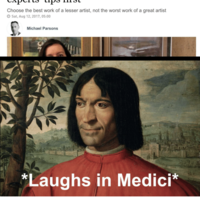More about Benvenuto Cellini
- All
- Info
- Shop
Works by Benvenuto Cellini

Sr. Contributor
Hide your kids. Hide your wife. Hide your husband. Cause Benvenuto Cellini's murdering everybody in Renaissance Florence.
While his artistic creations were popular with Popes, Kings and the like, he's famous for his kill-a-minute autobiography. It's a harrowing read, but he'd get the "Million Little Pieces" treatment if it were in Oprah's book club. For instance, Old Ben Cellini claims to kill the constable of Bourbon and wound the duke of Orange when the pair besiege Rome, taking the Pope prisoner. His version of it has him all but win the battle with an arm tied around his back. Yeah, probably not. Or, there's the time Michelangelo calls Cellini the greatest artist of all time. By the second time Cellini is summoning thousands of Hell's worst demons in the Colosseum, you just feel bad for him. It's like listening to your drunk uncle's career delusions just before he starts quietly sobbing.
Cellini was in and out of trouble his entire life. His first exile from Florence was in his late teens, for murdering a fellow youth. Decades later, he was arrested and imprisoned for allegedly embezzling the Pope's jewels. He was proven innocent, but not before a daring prison escape that left him falling several stories out of a castle, fighting off a pack of dogs, and crawling through the streets with a broken leg and busted skull toward freedom... only to be discovered minutes later and brought back to his cell.
Being in constant trouble, Cellini pissed off a lot of people. As such, he was poisoned twice. The first time, his enemies du jour attempted to lace his salad with pounded diamonds. However, the druggist enlisted to grind the diamonds kept the rock for himself and offered a harmless substitute. The second time, Cellini was poisoned by a business partner and took a year to fully recover.
Cellini has been referenced regularly in books, movies, and news stories for the last several hundred years. In addition to sundry operas and plays, Cellini is a favorite for many great novelists. Herman Melville in "Moby Dick," Mark Twain, Balzac, Alexandre Dumas, Agatha Christie, and Nathaniel Hawthorne all expressly call out Cellini's genius. Even Ian Fleming in "Goldfinger" has Bond reflect on the titular villain's greatness by comparing him to two figures: Einstein and Cellini, and not in that order. A fictional Venus by Cellini is at the center of the story to the classic Audrey Hepburn and Peter O'Toole film "How to Steal a Million."
Salvador Dali cites Cellini as one of his great influences. Dali even provided illustrations to a 1946 edition of Cellini's autobiography. The surreal imaginings of Cellini's adventures are literally the only thing that could make the story more fantastic. Dali's interpretation of Cellini is required viewing for anyone who's ever wondered, "What would Benvenuto Cellini look like with a bird-prism for a hat whilst vomiting a caterpillar?" The answer: Horrified and horrifying.

Contributor
In the 1966 movie "How to Steal a Million", Peter O'Toole refers to Cellini as "an over sexed Italian".
Fortunately for us, Cellini is one of the very few renaissance masters to have written an autobiography (or more accurately, dictated one to his 14 year old boy-toy), and even more fortunately for us, that autobiography is a salacious tell-all. Tidbits include:
1) He kept models in his house for the purposes of painting them and his "pleasure."
2) When one of his assistants slept with one of his model girlfriends, Cellini forced the assistant and the model to marry, then made the model pose nude for long periods of time in uncomfortable positions...then slept with the now-married model for the sole purpose of getting back at his assistant.
3) A letter from Michelangelo that says in part "My Benvenuto– I’ve recognized you for many years as the greatest goldsmith of whom we have ever heard, and now I shall recognize you equally as a sculptor." The only problem is that Cellini was a known liar, and there is no proof that he did not just make this, and everything else up.
Featured Content
Here is what Wikipedia says about Benvenuto Cellini
Benvenuto Cellini (/ˌbɛnvəˈnjuːtoʊ tʃɪˈliːni, tʃɛˈ-/,
Italian: [beɱveˈnuːto tʃelˈliːni]; 3 November 1500 – 13 February 1571) was an Italian goldsmith, sculptor, and author. His best-known extant works include the Cellini Salt Cellar, the sculpture of Perseus with the Head of Medusa, and his autobiography, which has been described as "one of the most important documents of the 16th century".
Check out the full Wikipedia article about Benvenuto Cellini

















